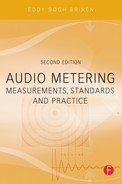Chapter | two
From Acoustic Sound to Electrical Signals
CHAPTER OUTLINE
In order to be able to measure, manipulate, or describe sound, we generally have to convert it from an acoustic to an electrical signal.
Sound exists in purely acoustical terms as pressure variations in the air. By using an appropriate transducer, for example a microphone, these pressure variations can be transformed into variations in current or voltage.
If we wish to record the sound, we then have to convert these electrical variations into another form. In the past these variations were widely used to leave magnetic traces on an audio tape or physical variations in the surface of a vinyl record. Today we mostly convert the sound into sequences of numerical values, as is the case with digital technology. Computer technology can subsequently be used to save or process these values, which presumably will end up as acoustic information again at a later date.

FIGURE 2.1 From acoustic sound to electrical signal and back to acoustic sound.
ELECTRICAL SIGNALS
When a microphone is used to convert acoustic information to electrical information, we say that the electrical signal is analogous to the acoustic signal. In other words, the waveforms that describe the pressure and voltage or current variations resemble each other.
In the electrical world we have a circuit in which a current of electrons flows. A potential difference drives the electrons in one direction or the other. It is the size of this potential difference, the voltage, which we most often regard as the magnitude of the signal.
SPEED
The movement of the electrons occurs at a speed close to the speed of light, which in a vacuum is 2.99792458$108 m/s [9.8293$108 ft/s]. In practice, we use a rounded value of 3$108 m/s, or 300,000 km/s [186,000 miles/s].
Clearly, electrical signals moves at a much higher speed in a wire than acoustic signals propagate in air.
WAVELENGTH
The wavelength of the electrical signal in cables and transmission lines is determined by the same expression that is used for acoustic sound:
where
λ = wavelength [m]
c = speed [m/s]
f = frequency [Hz]
or
λ = wavelength [feet]
c = speed [feet/s]
f = frequency [Hz]
In the audio frequency range (20 Hz – 20 kHz) we thus have wavelengths ranging from 15,000 km down to 15 km or from 9000 miles down to 9 miles. As opposed to acoustic sound, which propagates in the air, very seldom will audio converted to electrical signals have wavelengths that are of the same size as the circuits we are working with. In practice, this will for the most part only occur when we are using cables with lengths in kilometers or miles.
If, however, we are working in the high frequency spectrum, for example with video or radio frequencies, or with transmission of digital signals, then the wavelengths will very quickly turn out to be comparable with the sizes of the physical circuits in which the current is flowing.
